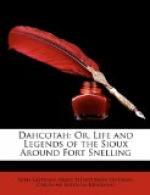They told me afterwards, that “much water fell from their eyes day and night, while they thought she would die;” that the servants made them leave the sick room, and then turned them out of the house—but that they would not go home, waiting outside to hear of her.
During her convalescence, I found that they could “rejoice with those that rejoice” as well as “weep with those that wept.” The fearful disease was abating in our family, and “Old Harper,” as she is called in the Fort, offered to sit up and attend to the fire. We allowed her to do so, for the many who had so kindly assisted us were exhausted with fatigue. Joy had taken from me all inclination to sleep, and I lay down near my little girl, watching the old Sioux woman. She seemed to be reviewing the history of her life, so intently did she gaze at the bright coals on the hearth. Many strange thoughts apparently engaged her. She was, of her own accord, an inmate of the white man’s house, waiting to do good to his sick child. She had wept bitterly for days, lest the child should be lost to her—and now she was full of happiness, at the prospect of her recovery.
How shall we reconcile this with the fact that Harper, or Harpstinah, was one of the Sioux women, who wore, as long as she could endure it, a necklace made of the hands and feet of Chippeway children? Here, in the silence of night, she turned often towards the bed, when the restless sleep of the child broke in on her meditation. She fancied I slept, but my mind was busy too. I was far away from the home of my childhood, and a Sioux woman, with her knife in her belt, was assisting me in the care of my only daughter. She thought Dr. T. was a “wonderful medicine man” to cure her; in which opinion we all cordially coincided.
I always listened with pleasure to the women, when allusion was made to their religion; but when they spoke of their tradition, I felt as a miser would, had he discovered a mine of gold. I had read the legends of the Maiden’s Rock, and of St. Anthony’s Falls. I asked Checkered Cloud to tell them to me. She did so—and how differently they were told! With my knowledge of the language, and the aid of my kind and excellent friend Mr. Prescott, all the dark passages in her narration were made clear. I thought the Indian tone of feeling was not rightly appreciated—their customs not clearly stated, perhaps not fairly estimated. The red man, considered generally as a creature to be carried about and exhibited for money, was, in very truth, a being immortally endowed, though under a dispensation obscure to the more highly-favored white race. As they affirmed a belief in the traditions of their tribe, with what strength and beauty of diction they clothed their thoughts—how energetic in gesture! Alas! for the people who had no higher creed, no surer trust, for this and for another world.




